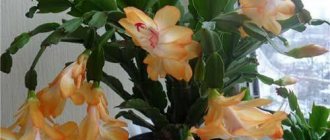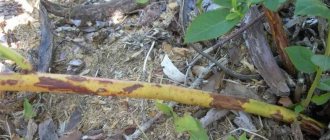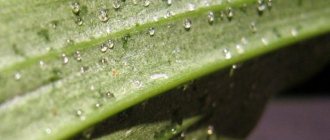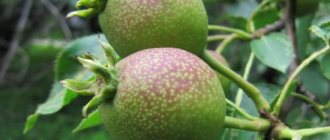What are the reasons for the redness of the leaves of the Decembrist
To understand why the Decembrist leaves turn red, you need to navigate the conditions of its detention.
Several factors can cause the color change. The most important reason is that the zygocactus froze. At temperatures below +5 C degrees, the forest cactus changes color. The flower will not die, but it is better to move it to a room with normal temperature.
Too much bright light
Under natural conditions, Christmas tree grows as an epiphyte in the shade of trees, so it does not like bright light. East or west windows are suitable for growing it at home; in particularly hot times it can be moved to the north side.
What to do: If the plant is located in the southern part of the room, then it must be shaded. Otherwise, spots of red or purple color will begin to appear on its leaves. In addition, the flower may get sunburned or its outer segments will begin to fall off.
Growth of new segments on leaves
At the beginning of spring, new segments begin to grow on the leaves of the plant, so the tips of the leaves become red. In this case, there is no need to worry; as they grow, they will become their normal green color.
Incorrect feeding
For the good development of the Decembrist, proper feeding is of great importance. It begins in mid-autumn and stops after flowering ends. To do this, you can use fertilizers for cacti. They contain a sufficient amount of nitrogen, potassium, phosphorus, magnesium and other elements that are necessary for the Decembrist.
Excessive watering
Decembrist does not like severe waterlogging of the soil. Watering should be regular, but not strong, and the top layer of soil should dry out between waterings. Frequent overwatering leads to the fact that the root system begins to rot, and the foliage withers and turns red.
What to do: To prevent the plant from dying, you need to let it dry thoroughly and then adjust the watering regime. If possible, it is recommended to transplant the plant into new soil, after washing the root system and removing rotten parts.
Schlumbergera received its second name due to its abundant flowering in December. How beautiful a flowering plant looks on the windowsill when there is snow and blizzards outside.
If you provide the plant with proper care, it can delight you with beautiful flowers every year. The flower is quite easy to care for, so it can be found among many gardeners.
But, despite its undemanding content, the Decembrist can be attacked by pests and various diseases. In this article we will take a closer look at the main reasons for the redness of the leaves of this magnificent flower.
Other diseases and pests that affect the plant
In addition to what is described above, when growing Decembrist, flower growers may encounter other problems:
- The leaves have wilted , become pale and lifeless - there are several reasons: pest damage, sunburn or drying out of the earthen ball in the pot. Inspect the plant and balance the care.
- Brown spots appear on leaf segments - sound the alarm, the plant has been infected by scale insects. To combat this pest, a simple laundry soap is suitable, which needs to be used to treat the leaves on all sides. if this measure does not help, you can buy an insecticide in the store and spray the flower.
Important! If the drug turns out to be ineffective, there is only one thing left to do - cut off all the damaged areas, otherwise the plant will die.
It is difficult to remove this parasite, since microscopic insects can even settle in curtains. Therefore, once every 2-4 days, give the plant a shower with a soap solution or buy a special preparation that should be used to treat not only the plant, but also the space around it. If the mite is not found, then move the plant in the pot; the roots may have rotted.
Schlumbergera is a magnificent, flowering plant that can be susceptible to various diseases and pests. But don’t worry too much, just give your indoor plant a little more attention and time. Remember - this is a living organism that feels your attitude towards it.
Preventing the problem from recurring
Growing the Decembrist flower at home: care, signs, varieties
In order for the plant to be healthy, it needs to be properly cared for, for this:
- The soil
. Decembrist loves loose, permeable, nutrient soils, with small inclusions of different fractions - this could be tree bark, coal, perlite or broken brick. It is worth considering that drainage should occupy 1/3 of the flowerpot. - Air humidity
. If the room is dry, then the flower needs to be constantly sprayed; the plant responds well to water treatments - shower every week.
Temperature
There are no special recommendations here; it is important that the air temperature does not fall below +10 degrees.
Provide proper lighting - the Decembrist will feel good on northern windows and north-western window sills, away from direct sunlight. If all windows face south, then it is better to install the plant in a room where only scattered rays penetrate. Decembrist can be taken out into the fresh air in the summer, but it must be in the shade.
Watering
The water should be at room temperature and settled. You need to water the plant only when the top layer of the earthen clod dries out by 5 cm. You need to understand that the lower the temperature in the room, the less often the plant is watered. It is good if watering is combined with spraying.
Feeding. Fertilizers must be applied in a timely manner during the active growing season of the plant - from autumn to spring. The frequency of fertilizing is once every 2 weeks, and it is worth alternating organic fertilizers and mineral complexes.
If you take into account all the recommendations for growing this magnificent flower, then it will delight you with vigorous flowering every year.
Caring for the Decembrist at home
Decembrist: reproduction at home, care features, photo
How to care for a beautiful Decembrist indoors? It is enough to follow a few important rules, which are described below in this article. And then the cactus will delight you with its flowers.
Location and lighting
It is necessary to place the flower in an area of diffused sunlight. It must be remembered that direct sun inhibits plant growth. It is best to place it near windows. A good place for this plant is a north window. In the summer, the Decembrist is taken out into the fresh air, but it should be protected from direct sun.
It is not uncommon for more leaves and shoots to appear on the light side. This is why the flower needs to be rotated regularly. But when buds appear on the plant, it is better not to carry out this procedure.
Watering
In summer and spring, the plant is watered as the substrate dries. In the fall, before flowering, Decembrist is watered no more than once a week. As soon as the buds appear, the plants need to be watered generously and sprayed daily.
Reproduction and transplantation
The plant usually propagates by cuttings. To do this, you need to separate cuttings with two segments from the mother plant. Then they need to be dried for several days and placed in a moist substrate.
The plant is replanted after it has flowered. Young plants need to be replanted after 2 years, and adult plants after three years. In this case, it is necessary to form the plant by pinching off segments of the stems.
This plant has a rather weak root system, for this reason the plant needs to be planted in a spacious but shallow container. The plant should be planted in a light, breathable substrate.
Pests
Decembrist may be affected by spider mites (rusty coating on the leaves). Also, white, cotton-like lumps between shoots are a sign of mealybugs. The plant is also affected by fungal diseases: fusarium, late blight and phytium. At the same time, the flower becomes sluggish and pale. Fungicides are used to control fusar. To combat late blight and phytium, the products “Maxim”, “Topaz”, “Vitaros” will help.
Reanimating a flower
If the cause of the Decembrist's lethargy is low or high temperature, lack of fertilizers, excessive watering or lack of light, then the first and most common resuscitation measure is re-rooting. Pinch off three or four leaves of the dying plant and place them in water for two weeks.
After the roots appear, you need to move them to a new pot with drainage holes and specialized soil for cacti. After some time, add the old one to the new flower and do not feed it for the first month.
Watering
Proper care of the Christmas tree includes timely watering with settled water at room temperature. It tolerates a lack of moisture in the soil more easily than its excess. In addition, when the cactus dries out, it can form special roots that absorb moisture from the air.
Basically, watering is determined by the condition of the soil, and the rate of drying of the soil depends on the humidity and temperature of the environment. It is worth watering the Christmas tree if the top layer of soil has dried out a couple of centimeters (about 1 centimeter every two weeks).
During flowering, the soil dries out much faster, which requires more frequent moistening (every three or five days), and during dormancy the number of waterings should be reduced. It is not recommended to do this before night.
Getting rid of infections
Treatment for parasites:
Spider mites cause significant damage to the plant. If you look closely, you can see it with the naked eye. The cactus should be treated with preparations (Neoron, Actellik, Fitoverm) with intervals of 3-4 days at +30 degrees and 9-10 at +20.
You need to wash the flower well with laundry soap twice and leave it soapy for 2 hours, then to get rid of the laid eggs, store the plant in a bag for 7-10 days (if necessary, it is recommended to do the procedure again).
If a mealybug is detected, treat with Confidor or Aktar (2 ml of the drug per 200 ml of water), repeat after 7 days. There are also several traditional ways to combat this parasite:
Make a solution with garlic in boiling water, leave for 6 hours, then treat the zygocactus in the evening and cover from the sun for two days.
Mix 40 ml of olive oil with a liter of water and wipe all areas of the Christmas tree.
Dissolve grated green soap in water and spray three times every 7 days.
Scale insects deprive the plant of all necessary juices, the leaves turn yellow and dry. To preserve Decembrist, you should treat it with a solution of Tanker or Karbofos on all affected areas. Traditional methods:
Prepare a mixture with laundry soap (40g per liter) and five drops of kerosene, treat the affected areas.
Fill the finely chopped onion with water and leave for three hours, filter the resulting solution.
Treatment for infections:
The main fungal infections are pythium and late blight. To treat these diseases, it is recommended to use the following drugs:
Speed: 1 ml diluted per liter of water.
Topaz: 2 ml is taken per 10 liters, treated at the first symptoms of damage.
Maxim: 5 drops per 200 ml of water.
Vitaros: for 2 liters - 2 ml of the drug, sprayed twice with a break of ten days.
For the prevention of fusarium, Bayleton or Micol are used.
If the plant is sick, it is not possible to cure it, so the affected part should be removed and the soil should be treated with a weakly concentrated solution of potassium permanganate.
A sign of bacterial infection of zygocactus is: a wet dark spot that gradually grows throughout the flower, in some cases red slippery pigmentation on the faded area.
It is useless to treat bacterial diseases; it is necessary to remove the affected areas of the Christmas tree. If the disease has affected only part of the stem, you can break off a higher cutting and grow a new cactus.
Pruning and replanting
White Decembrist flower, Christmas tree, Zygocactus Schlumbergera: homeland of the plant, care at home
In order for the Decembrist to bloom many more times, it needs to be replanted soon after the last flower falls. Since during this period the zygocactus is greatly depleted, it needs to renew the soil.
It is important to trim off unnecessary branches. It is advisable to do this every spring, otherwise the Decembrist will grow so large that it will no longer be able to bloom normally.
At the same time, in the fall, young shoots will definitely appear on which buds will grow.
If the crown is trimmed beautifully and on time, the Decembrist will give a lot of leaves and become more fluffy in appearance
In care, it is important to adhere to the golden mean: do not shade the plant too much in summer and do not create artificial light in winter.
Decembrist, or as it is also called, is a zygocactus, a forest cactus, a rather unpretentious plant. But in order for it to bloom regularly, you will have to create the necessary conditions. The plant needs to be properly fed and watered; around the end of August, the amount of fertilizer and moisture should be significantly reduced, reducing everything to simple irrigation. In early November, more frequent watering of plants in houses should be resumed, so that by December the tropical pet will please the owners with abundant flowering.
Let's consider why the indoor Decembrist did not bloom in due time or suddenly stopped blooming. The culprit may be a violation of simple rules for caring for the plant.
Lack of lighting
On the one hand, the plant does not like a lot of light, on the other hand, too little is also bad.
Decembrist needs diffused lighting all year round. There is no need to equip additional lighting.
Intense lighting is important in September-October
when flower buds are formed.
It falls in November-January, when there is short daylight. At this time, light no longer plays a major role. In addition, for a full-fledged process, the Christmas tree needs a long night, during which it rests.
Incorrect temperature
A typical mistake for inexperienced gardeners. The air temperature in the room should not fall below +15°C
After the onset of the autumn season, the Decembrist should be moved into the house. There is no need to leave it on balconies, open terraces, or verandas.
Temperature conditions for flowering
- Air temperature +18-20°C is important for the growing season.
- When buds form: +12-14°C.
- During flowering: +15-18°C.
No rest period
Decembrists are plants that bloom in winter
Therefore, it is quite important for them to have a period of rest. This time begins in mid-October and lasts until the end of November
Then there is no need to touch the plant. It is necessary to moisturize once every 2-3 weeks with a small amount of water. And put the flower in a cool room. It is important to arrange such a dream for the flower 50 days before the onset of the budding process.
Big pot
Some flower lovers think that if you plant a plant in a spacious pot, it will do well there. But not every plant has such a developed root system.
When sufficient space is obtained, its roots begin to grow and actively develop. At the same time, there is no longer enough strength for flowering. It is better to plant the Decembrist in a low and wide pot
Moving
The flower reacts sharply to changes in location, as well as to turns and movements. Once the buds begin to appear, the flower container should not be touched. Otherwise, the plant begins to panic and drops its buds.
Humidity
It is impossible not to note an indicator that plays a vital role in the life cycle of exotic plants - humidity. If the air space in the room is dry, then the zygocactus cannot set flower buds at full strength. If there is insufficient moisture, the plant, preparing for the flowering phase, often drops its buds. Then the next flowering should be expected no earlier than in 12 months.
Diseases and pests
Schlumbergera or Christmas tree, like other indoor flowers, is attacked by harmful insects that feed on the sap of the plant, as a result of which it loses vitality, resistance to infectious diseases decreases, and as a result does not bloom.
The main domestic enemies of the Decembrist
- mealy nigella;
- scale insect;
- spider mite
When infested with spider mites, you can notice a yellowish base with reddish splashes.
As a result of damage by spider mites, the zygocactus sheds a significant part of the segments and buds.
No less pleasant phenomena for the Decembrist are fungal diseases
- late blight;
- fusarium;
- Pythium.
They mainly affect a weakened plant, aggravating the condition. If you do not pay attention to the symptoms that arise in time, the flower will die.
It is important to note that harmful insects enter the house through the soil, which is not disinfected
.
Causes of redness of Decembrist leaves
Hypothermia
This is the most common cause of Decembrist redness. Many gardeners know that the plant tolerates low temperatures quite well. In addition, to prepare for flowering during the dormant period, the Decembrist even needs to be placed in cool conditions. The ideal temperature for the plant in autumn is 10-18°C. However, if the flower is supercooled and left at a temperature below 8°C for a long period, it will immediately indicate freezing by turning the leaves red.
In this case, you urgently need to bring the plant into a warm place. However, you should not place it near the battery so that it “warms up”. Too sudden changes in temperature and dry air can provoke other difficulties, which will also lead to leaf fall. Ideally, simply place the flower at room temperature, for example, place the flower on a north or west window.
Sunburn
Which window should I put the Decembrist on?
Decembrist is an epiphyte; in natural conditions it grows on tree trunks, branches, snags and stumps. Therefore, it is constantly in light shade and prefers diffused sunlight. Accordingly, direct sunlight can be harmful: they can cause burns, which will appear in the form of brown or red spots.
To prevent burns from occurring, it is recommended to allocate a place for the Decembrist, again on the north or west window. And on clear days, be sure to cover the flower from direct rays.
Abundance of moisture
Watering the Decembrist
The Decembrist cannot stand overflow. Remember, it tolerates drought much easier than overwatering. If the plant is watered too often and abundantly, it can cause rotting of the root system. And this will inevitably lead to redness and wilting of the leaves of the plant.
Therefore, monitor the watering regime of the Christmas tree: give moisture only after the top layer of soil has completely dried. During the dormant period, it is enough to water the plant once every 2 weeks; during the period of active growth, once a week, or even more often; during budding, watering is again reduced to once every 2 weeks, and during flowering, we return watering to the frequency of once every 3-5 days.
If you are sure that the redness of the foliage is due to the overwatering of the plant, it is better to replant it so as not to completely destroy it. Prepare a pot a couple of centimeters wider than the previous one, lay drainage on the bottom, and loose soil on top. Free the Decembrist from the old soil, rinse the roots with warm water, cut off the rotten ones, and powder the sections with activated carbon. Carefully replant the plant into new soil and leave it for a couple of days in a shaded room so that the Decembrist gets comfortable in the new pot.
Phosphorus deficiency
The deficiency of this particular macroelement is manifested by redness of the leaves. In addition, the plant stops growing, refuses to bloom, and loses resistance to diseases and infections.
Interesting on the topic:
How to make Decembrist bloom?
How to make a money tree bloom?
Therefore, do not forget to feed the Decembrist and monitor the dosage of fertilizers. If the leaves turn red, prepare a complex fertilizer that focuses specifically on phosphorus. As a folk remedy, you can use an infusion of ash.
Natural process
The tips of the leaves of the Decembrist are turning red
However, there are also natural reasons for this phenomenon. If in the spring the leaves begin to turn red at the tips, it means that the process of forming new segments of shoots is simply underway. This is a normal process, in this case there is no need to worry about the plant.
The redness of Decembrist leaves is mostly a consequence of improper care of the plant. Therefore, in order for your Christmas tree to make you happy, bloom profusely in winter and not get sick, be sure to follow all the recommendations listed above.
Other possible problems and what to do to fix them
In addition to all of the above, the flower may develop:
- limp and dry leaves. Wrinkled, limp leaves on Decembrist with signs of drying indicate unbalanced watering, possible location near dry hot air (near the battery) or under scorching sun rays;
- leaves fall. The Decembrist sheds its leaves due to the appearance of pests, lack of nutrients, stress due to sudden temperature changes and untimely transplantation;
- thin leaves. The problem occurs when parasites appear in the soil and insufficient fertilizing in the form of mineral and organic fertilizers;
- the leaves turn yellow. Insufficient levels of air and soil humidity, and a lack of microelements can cause yellowing of Decembrist leaves. The presence of a pest, scale insects, is also possible.
Sometimes it happens that the plant looks healthy, but for some reason the Decembrist does not grow. The reason may be a cramped pot, and the flower requires replanting. Over time, the soil becomes compacted and ceases to allow the required amount of air to pass through, and sometimes the root system fills the entire container and becomes cramped. A young Decembrist needs to be transplanted into a new flowerpot once a year, a mature one - once every 4-5 years.
Thus, the Christmas tree is bothered by many fungal, bacterial diseases, as well as pests. Only a thorough inspection of the plant will allow you to detect the problem in time and solve it. However, it is important not to overwater the flower, since the plant has a very sensitive root system; excess moisture will lead to its rotting. It is better to use a tray for watering.
Schlumbergera flowering in winter
The shade-loving plant will not withstand direct sunlight and indoor heat. “Moving” from your usual place can also be disastrous. Do not forget to feed the flower with mineral fertilizers and periodically replant it. With proper care, the flower will not keep you waiting long: when the coldest time of the year comes outside, the Decembrist will begin to bloom and appear in all its glory.
Why the Decembrist withers and how to save it
Decembrist (Schlumbergera, Rozhdestvennik, Zygocactus) is a fairly popular plant. However, sometimes you can't wait for the flowers to appear. Let's look at what could be the cause and how to deal with it.
Basic rules for growing Decembrist
Decembrist is one of those plants whose buds bloom in winter. In order for the plant to grow well and bloom at the right time, you need to follow some growing rules. The location is chosen to be bright, but without direct sunlight. The temperature in summer should be within +18...+20 °C, and in winter -+13...+15 °C
It is important not to forget about the high level of humidity.
Infections
This is one of the main reasons that cause the leaves to wrinkle and wilt. Most often, such consequences occur when the plant is damaged by pythium (the so-called type of root rot) and late blight. As a result, there is a loss of connection between the roots and the stem. And even despite the soil being moistened, the leaves do not receive the required amount of moisture and nutrients. The Decembrist is quite often affected by spider mites.
Content errors
In addition to infections, limp leaves can appear if Decembrist is not maintained correctly. These include the burning rays of the sun, inappropriate temperature and excessive watering. In this case, the place where the pot with the plant is placed is shaded, the temperature regime is optimized to +18...+22 °C and the amount of water when watering is reduced.
Root system diseases
Sometimes rotting of the root system occurs not due to infections, but for other reasons. Most often, this is due to waterlogging of the soil at low temperatures. In such conditions, acidification of the soil occurs and, as a result, a lack of oxygen at the roots and their rotting. It's quite easy to check. Observe the flower. If it sways and can be easily pulled out of the ground, it means there are no living roots as such.
How to prevent the problem
To prevent such problems, preventive maintenance is recommended from time to time.
You need:
- monitor the watering regime;
- protect the flower from extreme heat;
- carry out transplantation on time;
- inspect the plant at the time of the presence of any deviations from the norm.
Useful tips for growing and caring
In order for the Decembrist to grow and bloom for many years, strict adherence to the rules for caring for it is mandatory.
Here are some of them:
- For irrigation use only soft water. In hot weather, spray the leaves.
- Fertilizers are applied no more than 2 times a month.
- In the warm season, the pot is taken out to the balcony.
- In autumn, the amount of watering is gradually reduced, and the pot is moved to a cool place.
- The signal for watering is the obvious drying of the top layer of soil.
- Cactus fertilizers, which can be purchased at a specialty store, are used as fertilizing.
- To form a beautiful crown, regular pruning is necessary to remove old and dried branches.
- Between flowering, the plant needs to create conditions for recovery. This should be a place with light partial shade and quite warm.
- Every few years the plant must be replanted.
Video: recommendations for growing Decembrist
There are several reasons why Decembrist leaves become soft. However, by becoming more familiar with them, they can be prevented and the plant protected.
What to do if the leaves turn red?
Sometimes the leaves of a seemingly healthy plant begin to turn red. There are several reasons for this.
- There is too much bright light when Schlumbergera comes to its senses after vigorous flowering. This usually happens in spring and summer. To protect the flower from redness, you need to move the plant to where the light is diffused.
- A lack of phosphorus leads to a decrease in chlorophyll and the leaves turn red. Properly selected fertilizers will correct the situation, and the plant will delight with the rapid growth of bright greenery.
- Red leaves indicate excessive soil moisture. A regulated watering regime will solve the problem.
Young shoots may also have a reddish color along the edges, but nothing needs to be done here. As soon as the leaf grows, it will turn green.
Care and cultivation
Watering a flower
Cyclamens
- big fans of moisture. Therefore, do not forget to water them on time. But make sure that water does not get on the leaves of the plant, otherwise they will begin to rot.
Water the flower by pouring water into the pan. Or, as a last resort, carefully pushing the leaves away with your hand and watering along the edge of the pot.
If watered incorrectly, brown spots appear on the plant, which will later lead to the bush dying.
For watering Cyclamen
always use settled water. Do not use tap water. If you don’t have settled water on hand, you can always water the plant with boiled water cooled to room temperature.
Make sure that the water in the pot tray does not stagnate. After the plant is watered and well soaked, the remaining water from the pan must be drained.
Lighting
How to care for a Christmas star flower (Poinsettia)
The most suitable place for the successful growth of Cyclamen
, there should be a well-lit place, preferably with bright, diffused light.
Direct bright rays of the sun should be avoided. This means that the plant needs to be provided with some shading. However, the plant will respond gratefully to a small amount of sunlight in the morning or evening.
Top dressing
Cyclamen
should be fed during flowering and during the period of active leaf growth twice a month.
To do this, it is necessary to fertilize during watering with one of the special fertilizers for domestic flowering plants.
Try not to overuse nitrogen fertilizers. Their excess can negatively affect the quality and quantity of flowers, and will also lead to a powerful growth of foliage.
If you notice that the leaves of your plant have begun to turn yellow, use a fertilizer that contains iron. You can apply it directly under the root or by spraying.
By the beginning of April, fertilizing should be canceled and watering reduced. In this way, the plant is prepared for the dormant period. It is kept practically dry for about a month. All Cyclamen
at the same time they inevitably fall.
Bloom
The plant usually blooms in winter or summer. The duration and quality of flowering of a plant directly depend on its care. For maximum flowering time, it is necessary to provide the plant with intense lighting, only direct exposure to sunlight should be excluded.
The optimal temperature for a flower is from 10 to 20 degrees.
Watering the plant is carried out using the bottom method so that the plant does not start to get sick from water penetrating into the growth zone, on the leaves and flowers.
Withered, wilted flowers must be removed. The appearance of yellow leaves on Cyclamen
indicates that the plant has completed its flowering and entered the dormant stage. The yellow foliage should not be cut off; it must be unscrewed, carefully separating it from the bulbs.
Active watering should be completely reduced. A tuber lying quietly in the ground is watered only occasionally. The plant should be placed in the shade to rest until it reaches its next life stage.
Transfer
When transplanting Cyclamen
the old soil should be completely replaced with new soil, consisting of one part turf soil, one part sand and a leaf part.
When replanting, you should carefully examine the roots of Cyclamen
, while removing all diseased, suspicious and beginning to rot roots.
Pot for planting Cyclamen
Shouldn't be too big. Try to choose a pot with a diameter of 12 to 14 centimeters. If the pot is too small for the plant, it will bloom much earlier, and its flowering will be very weak.
For a neutral reaction, it is recommended to add a small amount of ash to the plant’s soil.
Roots of Persian Cyclamen
When planting, it should not be buried.
You need to leave about a third of the tuber on the surface. the roots of the Neapolitan Cyclamen
must be buried.
After the flower is planted, it is necessary to place it in the brightest place, slightly covering the sun's rays. The first couple of weeks after planting, watering the plant should not be abundant, until new leaves sprout and the plant is completely strong.
Hyacinth: how to care for a flower at home











